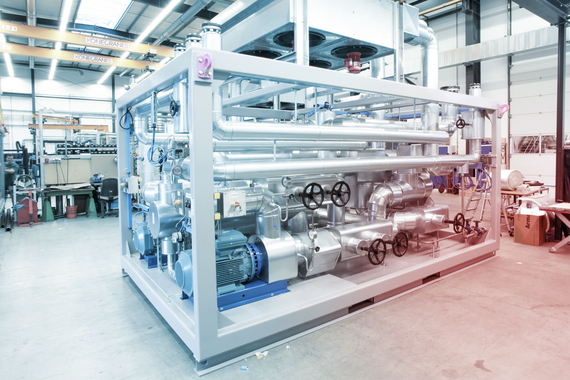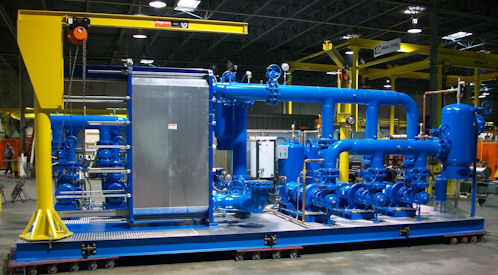A Comprehensive Overview to Choosing the Right Heat Transfer Solutions for Your Demands
Picking the suitable Heat transfer system is important for operational effectiveness. Different systems satisfy various needs, affected by variables such as temperature array and fluid kind. Recognizing the principles behind Heat transfer, such as conduction, radiation, and convection, is important. Additionally, evaluating energy resources and maintenance methods can impact long-term efficiency. A closer examination of these considerations reveals how to tailor a system to details requirements. What should one prioritize in this complicated decision-making procedure?
Understanding Heat Transfer: Key Concepts and Concepts
Although Heat transfer may feel like a simple concept, it includes a variety of concepts that are fundamental for effective system style. Recognizing these concepts is important for designers and developers who aim to optimize thermal performance in numerous applications. Conduction, as an example, includes the transfer of Heat with strong materials, while convection describes the activity of Heat within liquids. Radiation, an additional essential concept, explains exactly how Heat can be moved via electro-magnetic waves. Each of these systems plays an important duty in establishing how energy moves within a system. By extensively grasping these concepts, professionals can make informed choices, ensuring that Heat transfer systems operate effectively and meet the certain needs of their applications
Kinds of Heat Transfer Systems: A Review
Recognizing the concepts of Heat transfer prepares for checking out the numerous kinds of Heat transfer systems offered. Heat transfer systems can be categorized mainly into 3 kinds: radiation, convection, and transmission. Transmission entails Heat transfer via strong materials, counting on straight get in touch with in between fragments. Convection, on the other hand, happens in liquids (gases and fluids) where the activity of the fluid itself helps with Heat transfer. Radiation entails the transfer of Heat through electro-magnetic waves and does not require a tool, allowing it to happen in a vacuum cleaner. Each sort of system has distinctive qualities and applications, making it crucial for people and organizations to meticulously analyze their certain demands when choosing the most suitable Heat transfer solution.
Applications of Heat Transfer Equipments in Various Industries
Heat transfer systems play a vital duty across numerous industries, affecting performance and item top quality. In commercial manufacturing procedures, they help with specific temperature control, while in food and beverage handling, they guarantee security and conservation. Additionally, cooling and heating and climate control systems depend greatly on reliable Heat transfer to maintain comfortable environments.
Industrial Production Processes

Various commercial manufacturing procedures depend heavily on effective Heat transfer systems to optimize efficiency and enhance item quality. In markets such as metalworking, Heat exchangers play a necessary function in maintaining excellent temperatures during welding, spreading, and creating. These systems guarantee uniform Heat distribution, which is essential for accomplishing preferred material properties. In the chemical production sector, Heat transfer systems promote accurate temperature level control throughout reactions, affecting yield and safety. Additionally, in textile manufacturing, reliable Heat management is very important for coloring and completing processes, affecting shade uniformity and fabric quality. By choosing suitable Heat transfer technologies, makers can improve energy performance and minimize functional costs, ultimately bring about an extra sustainable and competitive manufacturing atmosphere.
Food and Drink Handling
Reliable Heat transfer systems are similarly essential in the food and drink handling industry, where maintaining optimal temperature levels is critical for food safety and security and high quality. These systems play a crucial function in procedures such as cooking, pasteurization, and sanitation, ensuring that items are safe for intake and keep their dietary value. Heat exchangers, for example, effectively move Heat in between fluids, enhancing energy usage while decreasing temperature fluctuations. In addition, refrigeration systems are essential for extending and preserving disposable items service life. The choice of Heat transfer innovation directly affects functional efficiency and product honesty, making it imperative for food and beverage suppliers to choose the suitable systems customized to their details processing needs. This careful option ultimately contributes to consumer contentment and food safety and security.

Heating And Cooling and Environment Control
While lots of sectors rely on Heat transfer systems for effectiveness, HEATING AND COOLING (Heating, Ventilation, and Cooling) plays a necessary function in maintaining interior climate control across numerous settings. These systems use Heat transfer principles to control temperature level, air, and humidity high quality, ensuring comfort and safety and security in domestic, business, and commercial settings. Appropriately designed heating and cooling systems boost power effectiveness, reduce functional costs, and minimize ecological influence. In commercial buildings, for instance, efficient climate control contributes to worker performance and client complete satisfaction. In industrial applications, HVAC systems assist keep perfect conditions for devices operation and item conservation. Picking the ideal Heat transfer system is important for meeting particular climate control demands and achieving general system performance.
Examining Power Sources for Heat Transfer Equipments
In examining power sources for Heat transfer systems, a contrast of sustainable energy choices and fossil gas factors to consider is essential. Sustainable sources, such as solar and wind, offer lasting alternatives that can decrease ecological effect. Conversely, nonrenewable fuel sources continue to be common because of their well established facilities and energy thickness, prompting a mindful evaluation of both alternatives.
Renewable Resource Options

Nonrenewable Fuel Source Factors To Consider
Examining fossil fuel factors to consider is vital for the effectiveness and sustainability of Heat transfer systems. Nonrenewable fuel sources, such as gas, oil, and coal, are conventional power sources that give considerable Heat result, making them prominent choices for industrial and residential applications. Nonetheless, their ecological impact, consisting of greenhouse gas exhausts and resource deficiency, increases problems. When picking a warmth transfer system, it is crucial to analyze the schedule, expense, and regulatory elements related to these fuels. Additionally, the performance of nonrenewable fuel source systems must be considered, as greater performance can reduce some ecological downsides. Eventually, a well balanced method evaluating efficiency and sustainability can direct decision-makers toward the most suitable Heat transfer option for their details needs.
Variables to Take Into Consideration When Selecting a Heat Transfer System
Picking an ideal Heat transfer system calls for mindful factor to consider of various elements that can substantially influence efficiency and performance. One vital aspect is the operating temperature array, which dictates the materials and design suitable for the application. In addition, the kind of fluid made use of in the system-- whether gas or liquid-- affects Heat transfer effectiveness and compatibility. The system's dimension and capability need to line up with the certain demands of the procedure to stay clear of inadequacies. Power resource availability is also important, affecting operating expenses and sustainability. The setup setting, consisting of area constraints and access for maintenance, plays a significant role in system selection. Regulative conformity and security requirements must be taken into consideration to ensure the system fulfills all legal needs.
Upkeep and Performance Optimization for Heat Transfer Equipments
Maintaining Heat transfer systems is essential for making certain maximum effectiveness and longevity. Routine maintenance tasks, such as cleaning Heat exchangers and checking insulation, help protect against effectiveness losses because of fouling and thermal connecting. In addition, keeping an eye on system parameters, including pressure and temperature, enables very early detection of abnormalities, reducing downtime and expensive fixings. Implementing a preventive maintenance timetable can optimize efficiency and prolong the lifespan of parts. Upgrading to sophisticated control systems can enhance functional performance best site by adjusting to varying lots and conditions. By prioritizing upkeep and efficiency optimization, drivers can achieve reduced power consumption, lower operational costs, and boosted overall system reliability, eventually leading to much better resource usage and an extra lasting procedure.
Future Fads in Heat Transfer Technologies
As industries increasingly focus on sustainability and energy effectiveness, future trends in Heat transfer technologies are readied to go through significant improvements. Developments such as advanced materials, consisting of carbon nanotubes and nanofluids, guarantee improved thermal conductivity and performance. Furthermore, the integration of renewable resource sources into Heat transfer systems is obtaining momentum, promoting environmentally friendly options. Smart modern technologies, consisting of IoT sensors, are expected to change monitoring and control, allowing real-time data evaluation for enhanced efficiency. The growth of modular and portable systems will assist in simpler installment and upkeep, catering to diverse applications. These developments suggest a shift towards even more sustainable, reliable, and versatile Heat transfer services, lining up with worldwide power objectives and ecological requirements.
Frequently Asked Concerns
What Are the Environmental Influences of Heat Transfer Solutions?
The environmental influences of Heat transfer systems can include greenhouse gas discharges, power usage, and potential thermal pollution. In addition, improper disposal of materials and ineffectiveness can add to source deficiency and environment interruption.
Exactly how Do I Compute the Cost-Effectiveness of a Heat Transfer System?
To determine the cost-effectiveness of a warm transfer system, one must assess first costs, functional expenditures, upkeep requirements, sites and power effectiveness, comparing these aspects against the expected life expectancy and efficiency of the system.
Can Heat Transfer Systems Be Utilized in Residential Setups?
Heat transfer systems can indeed be made use of in domestic settings. They offer effective heating and cooling services, making homes a lot more comfy while potentially lowering power expenses. Their versatility permits various applications in domestic atmospheres.
What Security Laws Relate To Heat Transfer Equipments?
Safety laws for Heat transfer systems generally include guidelines on upkeep, procedure, and installation. Conformity with neighborhood building ordinance, supplier requirements, and sector standards is vital to assure risk-free and effective system efficiency in various applications.
How Do Different Materials Affect Heat Transfer Effectiveness?

Conduction, for circumstances, involves the transfer of Heat with solid materials, while convection refers to the movement of Heat within fluids. Understanding the concepts of Heat transfer lays the foundation for discovering the numerous kinds of Heat transfer systems available. Heat exchangers, for instance, efficiently transfer Heat between fluids, optimizing energy usage while minimizing temperature level variations. In evaluating energy resources for Heat transfer systems, a comparison of eco-friendly power choices and fossil fuel factors to consider is essential. Steels, such as copper and aluminum, conduct Heat successfully, whereas insulators like rubber and glass reduce down Heat flow.